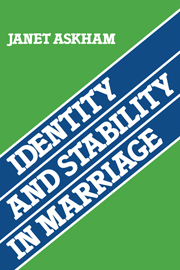Book contents
- Frontmatter
- Contents
- Preface
- 1 Prologue
- 2 Ways of looking at marriage: an introduction to the study
- 3 Knowing and talking to each other
- 4 Separate and joint activity
- 5 Constraints on behaviour within marriage
- 6 Changes in self and in activities
- 7 Relationships outside marriage
- 8 Conclusion
- Appendix 1 Sample selection
- Appendix 2 Interview guide
- Appendix 3 Profiles of the couples
- Glossary
- Bibliography
- Index
7 - Relationships outside marriage
Published online by Cambridge University Press: 07 October 2011
- Frontmatter
- Contents
- Preface
- 1 Prologue
- 2 Ways of looking at marriage: an introduction to the study
- 3 Knowing and talking to each other
- 4 Separate and joint activity
- 5 Constraints on behaviour within marriage
- 6 Changes in self and in activities
- 7 Relationships outside marriage
- 8 Conclusion
- Appendix 1 Sample selection
- Appendix 2 Interview guide
- Appendix 3 Profiles of the couples
- Glossary
- Bibliography
- Index
Summary
This chapter turns from self and the spouse to other people. Underlying the questions raised here is the suggestion that there may be conflict between a desire for personal, individual friends (in order to develop and maintain one's own sense of identity) and a desire not to have such friends nor encourage them in one's spouse (in order to maintain the stability of one's marriage relationship). Thus the specific questions asked in this chapter are: Do people have friends? Is any loss or gain of friends perceived as having been a consequence of marriage, or were there other reasons? How do people feel about friendship, and any loss or gain, for themselves and for their spouses?
Description of friendships
One of the difficulties in discussing ‘friends’ with interviewees is that the word ‘friend’ has particular connotations for them. It seems to mean people of approximately similar age to themselves, who are not relatives, and not one's marriage partner. Unfortunately there is no wholly satisfactory alternative phraseology: one can ask people whether there are others they are ‘close to’, or people they tend to do things with, or people they can talk to, and so on. Yet each of these questions may mean a restriction of the pool of acquaintances from which the interviewee draws his answer. One has therefore to use a variety of different probes to get near to answering the question of whether a person has other intimates or significant others besides his or her partner.
- Type
- Chapter
- Information
- Identity and Stability in Marriage , pp. 158 - 182Publisher: Cambridge University PressPrint publication year: 1984



